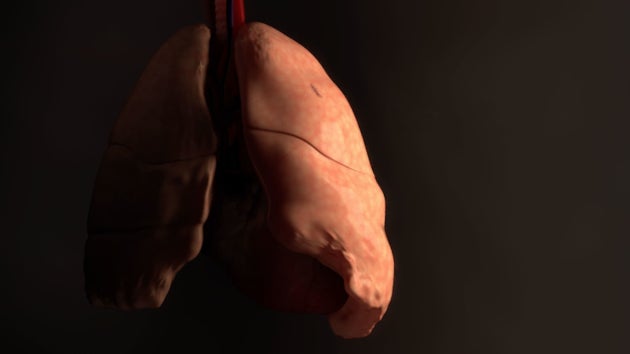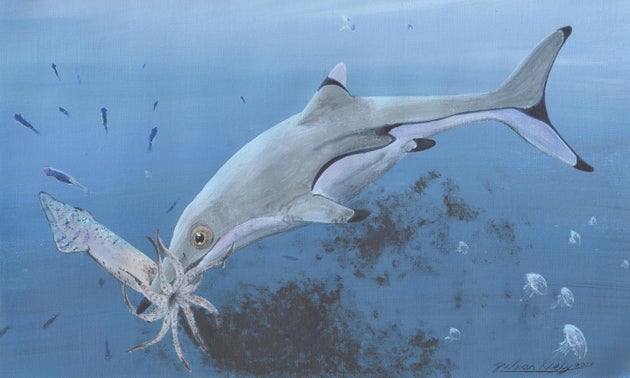check out this post on This Elastic Glue Can Seal Wounds In Under 60 Seconds
A highly-elastic glue could be the future of treating wounds inflicted in car accidents or war zones, after it was shown to successfully seal open incisions in less than one minute.
The “potentially life-saving” MeTro gel, which is just administered directly to the site of the injury by squirting it from a syringe, could transform the way surgery is performed by negating the need for common staples and sutures.
Professor Anthony Weiss said: “The potential applications are powerful.”

Elastagen Pty Ltd
A team of biomedical engineers, from the University of Sydney, developed the adhesive substance, which is similar to silicone sealants used around bathroom and kitchen tiles, according to Professor Weiss.
Once applied to the area, it is treated with UV light and sets within 60 seconds.
It is also at this stage that it can be treated with a built-in degrading enzyme that can be modified to determine how long it lasts (between hours and months) before disintegrating. Unlike stitches that would have often required removal.
Once it has degraded, there is no signs of toxicity left in the body.

Elastagen Pty Ltd
So far it has been most useful for sealing wounds in body tissues that continually expand and relax, such as lungs, heart and arteries, that are otherwise at risk of re-opening with classic methods of stitching.
It also works on internal wounds that are often in hard-to-reach areas and have typically required staples or sutures due to surrounding body fluid hampering the effectiveness of other sealants.

Elastagen Pty Ltd
Humans First Left Africa Because Of Climate Change
check out this post on Humans First Left Africa Because Of Climate Change
We know that humans first started to migrate our of Africa around 60,000 years ago, what we’ve never been entirely sure of is what caused the to do it.
New research led by a geoscientists from the University of Arizona has found however that the reason touches on a subject hat’s very much in the news now: Climate change.
Using the world’s most important collection of sediment cores from the deep sea the researchers were, incredibly, able to actually determine the temperature and climate from 60,000 years ago.
Previous research has suggested that when humans moved into Eurasia around 40,000-70,000 years ago north Africa needed to be wetter than it is now. What they found was very different.

raisbeckfoto via Getty Images
Using the sediment samples the team found that Africa had undergone a major transformation. Its previously fertile ‘Green Sahara’ had started to dry out, in fact at around the time humanity started to leave the Sahara was even drier than it is now, and a lot colder.
“Our data say the migration comes after a big environmental change. Perhaps people left because the environment was deteriorating,” explains Jessica Tierney, UA associate professor of geosciences.
“There was a big shift to dry and that could have been a motivating force for migration.”
What’s almost as impressive as their discovery is how they discovered it in the first place.
To create a long-term temperature record for the Horn of Africa the team analysed 4-inch segments of the sediment core with each section accounting for around 1,600 years.

LAMONT-DOHERTY EARTH OBSERVATORY
They then analysed the layers for chemicals called alkenones which are made by a very specific type of marine algae. As the temperature changes, so too does the composition of the chemicals being made by the algae, effectively allowing the team to take a temperature reading from 60,000 years later.
To figure out the rainfall the team did something equally as impressive.

gilaxia via Getty Images
They analysed the leaf wax that had blown into the ocean. Plants alter the chemical composition of their leaf wax depending on how wet or dry the climate is. By looking at the composition of the wax from that precise period in time they could tell exactly how wet or dry it was.
Nobel Prize In Chemistry 2017 Awarded For Imaging The Molecules Of Life
check out this post on Nobel Prize In Chemistry 2017 Awarded For Imaging The Molecules Of Life
The Nobel Prize in Chemistry 2017 has been awarded to three researchers, Jacques Dubochet, Joachim Frank & Richard Henderson, for their work on imaging the molecules of life.
The three, including Cambridge University’s Richard Henderson, were able to develop a revolutionary new electron microscopy imaging technique that can see these molecules at the atomic level.
Atomic structures of a) protein complex that governs circadian rhythm b) pressure sensor of the type that allows us to hear c) Zika virus pic.twitter.com/ixAyJesj99
— The Nobel Prize (@NobelPrize) October 4, 2017
“This method has moved biochemistry into a new era,” the Royal Swedish Academy of Sciences said in a statement awarding the $1.1 million) prize.
“Researchers can now freeze biomolecules mid-movement and visualize processes they have never previously seen, which is decisive for both the basic understanding of life’s chemistry and for the development of pharmaceuticals.”
The breakthrough has been compared to being able to actually photograph a person on the Moon from Earth in minute detail.
Traditionally one of the biggest hurdles in using electron microscopes is that the water surrounding these molecules simply evaporates in the vacuum chamber.
Nobel Prize In Chemistry 2017 Awarded For Imaging The Molecules Of Life
check out this post on Nobel Prize In Chemistry 2017 Awarded For Imaging The Molecules Of Life
The Nobel Prize in Chemistry 2017 has been awarded to three researchers, Jacques Dubochet, Joachim Frank & Richard Henderson, for their work on imaging the molecules of life.
The three, including Cambridge University’s Richard Henderson, were able to develop a revolutionary new electron microscopy imaging technique that can see these molecules at the atomic level.
Atomic structures of a) protein complex that governs circadian rhythm b) pressure sensor of the type that allows us to hear c) Zika virus pic.twitter.com/ixAyJesj99
— The Nobel Prize (@NobelPrize) October 4, 2017
“This method has moved biochemistry into a new era,” the Royal Swedish Academy of Sciences said in a statement awarding the $1.1 million) prize.
“Researchers can now freeze biomolecules mid-movement and visualize processes they have never previously seen, which is decisive for both the basic understanding of life’s chemistry and for the development of pharmaceuticals.”
The breakthrough has been compared to being able to actually photograph a person on the Moon from Earth in minute detail.
Traditionally one of the biggest hurdles in using electron microscopes is that the water surrounding these molecules simply evaporates in the vacuum chamber.
Nobel Prize In Chemistry 2017 Awarded For Imaging The Molecules Of Life
check out this post on Nobel Prize In Chemistry 2017 Awarded For Imaging The Molecules Of Life
The Nobel Prize in Chemistry 2017 has been awarded to three researchers, Jacques Dubochet, Joachim Frank & Richard Henderson, for their work on imaging the molecules of life.
The three, including Cambridge University’s Richard Henderson, were able to develop a revolutionary new electron microscopy imaging technique that can see these molecules at the atomic level.
Atomic structures of a) protein complex that governs circadian rhythm b) pressure sensor of the type that allows us to hear c) Zika virus pic.twitter.com/ixAyJesj99
— The Nobel Prize (@NobelPrize) October 4, 2017
“This method has moved biochemistry into a new era,” the Royal Swedish Academy of Sciences said in a statement awarding the $1.1 million) prize.
“Researchers can now freeze biomolecules mid-movement and visualize processes they have never previously seen, which is decisive for both the basic understanding of life’s chemistry and for the development of pharmaceuticals.”
The breakthrough has been compared to being able to actually photograph a person on the Moon from Earth in minute detail.
Traditionally one of the biggest hurdles in using electron microscopes is that the water surrounding these molecules simply evaporates in the vacuum chamber.
Online Safety: A Lesson All Students Need To Learn
check out this post on Online Safety: A Lesson All Students Need To Learn
August this year was an exciting month for those students finishing sixth form and college. After spending months disconnected from the world to focus on their studies, their A-Level results were released. For many, it was an opportunity to celebrate and let off some steam before setting off for pastures new. The prospect of university and expanding their minds, surroundings and opinions is too good to turn down for many people. It is where, some say, you ‘find yourself’. But during this rollercoaster ride of meeting new people and experiencing new things, it’s important to stay safe.
From spraying traceable SmartWater on possessions, to using anti-drink spiking straws, safety lessons are instilled into students by the bucket load as they leave for higher education. However, there isn’t much advice concerning their digital safety. We live in an age where there are just as many people looking to do you harm online as there are in real life and it’s important for students to stay vigilant. While it’s essential to enjoy their new home, they need to ensure their personal details are secure and that they’re the only one that can truly ‘find themselves’ online.
Recent attacks like the one on UCL in July show that universities are prime targets when it comes to cyberattacks. Students’ details are highly sought after and hackers have a number of ways of targeting them. From phishing scams like the one seen in September, where cyber scammers posed as the Student Loans Company, to the creation of a completely fictitious university, cyber-attackers are not short of creativity. Students need to be aware of their online behaviour and learn how to best mitigate risks. By following a few simple steps, students won’t have to worry about who can see their information, leaving them lots of extra time to attend those all-important lectures.
P1ck1ng Pa55w0rd5
Some people, no matter how many times they’re told, simply never change their passwords. They stick with predictable standbys and default options like ‘123456’ or even worse, ‘password’. Remembering them can be a chore, yes, but ensuring you have different passwords for each account is a necessity. If you don’t have the memory to remember all these different variations then a password manager is the answer for you.
Password managers greatly simplify the entire password process, enabling you to secure all your passwords behind one master password. All you have to do is remember one secure password and your accounts will auto-fill with their applicable passwords whenever you need access. Remembering one password isn’t too hard, right?
Keeping Social Media Social
Adding new friends on social media is a first step for many students cementing friendships. With so many fresh faces in such a short period of time it can be hard to keep track, but it really is imperative. Thousands of fake profiles are made every day with malicious intent, so be aware that it isn’t difficult for those same impersonators to list a university on their profile, too. Make sure you don’t accept anyone you haven’t physically met, no matter how attractive they are.
Sampling the offerings of your new surroundings is essential if you’re to feel at ease in your new home.
But as you post pictures on Instagram, or check-in on Facebook, remember that this information is permanent and available for many to see. It’s easier than you might think to accidentally reveal sensitive information such as your card details, address and when you’re out of the house, through pictures on social media. Be aware that most social media platforms are, in their essence, public.
Sharing Isn’t Always Caring
University is a time of sharing, from the accommodation you live in to the many group presentations you’re expected to do. Some of the most commonly shared things are the communal computers in the library. These shared devices can be used by dozens of people in one day, so remember to never click yes when asked to save your details. Keep track of which devices you’re logged in to and always sign out at the end of each session.
Wi-Fi hotspots are important for doing work while you’re out and about, but these open networks can also be ripe territory for hackers. When connected to the same public Wi-Fi, hackers can see which webpages you access and depending on how secure the sites you’re visiting are, your browsing history, searches, personal login information, photos, videos, emails, and comments. Use a Wi-Fi inspector app to analyse the security of the connection, or invest in a Virtual Private Network (VPN) to surf the net securely.
Be Cautious
Online Safety: A Lesson All Students Need To Learn
check out this post on Online Safety: A Lesson All Students Need To Learn
August this year was an exciting month for those students finishing sixth form and college. After spending months disconnected from the world to focus on their studies, their A-Level results were released. For many, it was an opportunity to celebrate and let off some steam before setting off for pastures new. The prospect of university and expanding their minds, surroundings and opinions is too good to turn down for many people. It is where, some say, you ‘find yourself’. But during this rollercoaster ride of meeting new people and experiencing new things, it’s important to stay safe.
From spraying traceable SmartWater on possessions, to using anti-drink spiking straws, safety lessons are instilled into students by the bucket load as they leave for higher education. However, there isn’t much advice concerning their digital safety. We live in an age where there are just as many people looking to do you harm online as there are in real life and it’s important for students to stay vigilant. While it’s essential to enjoy their new home, they need to ensure their personal details are secure and that they’re the only one that can truly ‘find themselves’ online.
Recent attacks like the one on UCL in July show that universities are prime targets when it comes to cyberattacks. Students’ details are highly sought after and hackers have a number of ways of targeting them. From phishing scams like the one seen in September, where cyber scammers posed as the Student Loans Company, to the creation of a completely fictitious university, cyber-attackers are not short of creativity. Students need to be aware of their online behaviour and learn how to best mitigate risks. By following a few simple steps, students won’t have to worry about who can see their information, leaving them lots of extra time to attend those all-important lectures.
P1ck1ng Pa55w0rd5
Some people, no matter how many times they’re told, simply never change their passwords. They stick with predictable standbys and default options like ‘123456’ or even worse, ‘password’. Remembering them can be a chore, yes, but ensuring you have different passwords for each account is a necessity. If you don’t have the memory to remember all these different variations then a password manager is the answer for you.
Password managers greatly simplify the entire password process, enabling you to secure all your passwords behind one master password. All you have to do is remember one secure password and your accounts will auto-fill with their applicable passwords whenever you need access. Remembering one password isn’t too hard, right?
Keeping Social Media Social
Adding new friends on social media is a first step for many students cementing friendships. With so many fresh faces in such a short period of time it can be hard to keep track, but it really is imperative. Thousands of fake profiles are made every day with malicious intent, so be aware that it isn’t difficult for those same impersonators to list a university on their profile, too. Make sure you don’t accept anyone you haven’t physically met, no matter how attractive they are.
Sampling the offerings of your new surroundings is essential if you’re to feel at ease in your new home.
But as you post pictures on Instagram, or check-in on Facebook, remember that this information is permanent and available for many to see. It’s easier than you might think to accidentally reveal sensitive information such as your card details, address and when you’re out of the house, through pictures on social media. Be aware that most social media platforms are, in their essence, public.
Sharing Isn’t Always Caring
University is a time of sharing, from the accommodation you live in to the many group presentations you’re expected to do. Some of the most commonly shared things are the communal computers in the library. These shared devices can be used by dozens of people in one day, so remember to never click yes when asked to save your details. Keep track of which devices you’re logged in to and always sign out at the end of each session.
Wi-Fi hotspots are important for doing work while you’re out and about, but these open networks can also be ripe territory for hackers. When connected to the same public Wi-Fi, hackers can see which webpages you access and depending on how secure the sites you’re visiting are, your browsing history, searches, personal login information, photos, videos, emails, and comments. Use a Wi-Fi inspector app to analyse the security of the connection, or invest in a Virtual Private Network (VPN) to surf the net securely.
Be Cautious
Incredibly, We Now Know The Last Meal Of A Creature That Lived 200 Million Years Ago
check out this post on Incredibly, We Now Know The Last Meal Of A Creature That Lived 200 Million Years Ago
If you’re anything like us you’ll struggle to remember what you had for dinner last night, but now scientists have managed to unearth the last meal eaten by a creature that died a staggering 200 million years ago.
The team were studying the fossilised remains of the ’Ichthyosaurus Communis’ – one of the first species of a group of sea-going reptiles that lived in the late Triassic and early Jurassic period in Europe and Asia.
The find was remarkable, firstly because it was the only example of a newborn ichthyosaurus ever to be found by humans, and secondly because it had a stomach full of prehistoric squid.

University of Manchester/Julian Kiely
The ‘Ichthyosaurus Communis’ lived in Belgium, England, Germany, Switzerland and Indonesia, and has been known to science for nearly 200 years, but this is the first time the team have uncovered such detail.
Paleontologist Dean Lomax, who worked on the study, said: “It is amazing to think we know what a creature that is nearly 200 million years old ate for its last meal.”
Measuring in at a total length of approximately 70cm (adult relatives normally grow up to 3.3 metres in length), the team at the University of Manchester, used a CT-scanner to create a 3D model of the animal.
Lomax said: “We then found many tiny hook-like structures preserved between the ribs. These are from the arms of prehistoric squid. So, we know this animal’s last meal before it died was squid.”
This also lead the team to conclude that younger examples of the species “fed exclusively on fish” and had a totally different prey-preference to their parents and other elders.
First discovered and recognised by science in 1821, with many uncovered by Victorian paleontologist, Mary Anning, along the coast at Lyme Regis, Dorset, the ichthyosaurus is one of the most common Early Jurassic fossil reptiles in the UK.
Despite this, there are few examples of complete or well-preserved fossils, making this find even more exceptional: “This specimen is practically complete and is exceptional. It is the first newborn Ichthyosaurus Communis to be found, which is surprising…”
It was initially believed that Ichthyosaurus laid eggs on land, but now fossil evidence shows that in fact the females gave birth to live young, and were born tail first to stop them from drowning in the water.
Scientists Discover Ice On Mars Where It Shouldn’t Exist
check out this post on Scientists Discover Ice On Mars Where It Shouldn’t Exist
Scientists have made an unexpected discovery while studying old images from the NASA archives – a region of ice near the Martian equator, where water simply isn’t meant to exist.
Everything we know about the red planet says water isn’t thermodynamically stable at low altitudes, but a team lead by researcher Jack Wilson, John Hopkins University, has now suggested that this might be wrong.
And this new information could be groundbreaking for any future Mars missions.

NASA
The images in question were first collected by the neutron spectrometer instrument on NASA’s Mars Odyssey spacecraft (the agency’s longest-operating Mars orbiter) between 2002 and 2009.
But have recently undergone some serious editing.
Wilson’s team were able to reduce blurring and remove ‘noise’ from the imaging data, improving the spacial resolution from approximately 320 miles to 180 miles, allowing us all a closer look.
“It was as if we’d cut the spacecraft’s orbital altitude in half,” Wilson said, “and it gave us a much better view of what’s happening on the surface.”
As a result they were now able to see evidence of ‘significant hydration’ near the equator, located between the northern lowlands and southern highlands along the Medusae Fossae Formation.
Spotting unexpectedly high quantities of hydrogen gathering at high latitudes, the planetary scientists knew this was a sign of buried water ice much lower down (even though the spectrometer itself can’t directly detect water).
This revelation is so mysterious because although hydrogen was always known to exist higher in the atmosphere, as confirmed by 2008 NASA’s Phoenix Mars Lander, but it was thought that this was impossible closer to the surface.
Indeed the team wonders how the water could be preserved there, with some speculations suggesting that it is only being held there by an ice and dust mixture cycled through the atmosphere the polar areas.
But those conditions last occurred hundreds of thousands of millions years ago and any ice deposited there should be long gone.
“Perhaps the signature could be explained in terms of extensive deposits of hydrated salts, but how these hydrated salts came to be in the formation is also difficult to explain,” Wilson added.
One In Four Teens Admit To Bullying Someone On Social Media – But Here’s Why You Shouldn’t Panic
check out this post on One In Four Teens Admit To Bullying Someone On Social Media – But Here’s Why You Shouldn’t Panic
In late 18th Century England, public concern over Imperial wars in America, India, and Europe, was matched by a growing fear of an altogether more insidious problem developing at home – the increasing mass consumption of novels!
‘My sight is every-where offended by these foolish, yet dangerous, books […] I have actually seen mothers, in miserable garrets, crying for the imaginary distress of an heroine, while their children were crying for bread’ – The Sylph no. 5, October 6, 1796: 36-37
For critics of this trend (which gained pace after the publication of Samuel Richardson’s Pamela in 1740), novels were seen as both psychologically and physiologically harmful: warping ideas of life and relationships, while also damaging readers eyesight and posture.
Fast forward a few hundred years, and this debate has echoes of current consternation around social media – albeit with the main focus of that concern moving from ‘ladies’, ‘mistresses’, and ‘belles’ to today’s young people. Look through any national newspaper and you’re likely to find at least one shocking story of abuse or crime linked to social networking sites.
However, while the tone of the debate on social media may have similarities to the novel-reading panic of the 18th Century, public anxiety in the contemporary case is backed up by empirical evidence. The NSPCC has, for instance, reported a doubling of Childline calls related to cyberbullying between 2012 and 2016, and a recent report by the OECD classified 37% of British 15-years olds as ‘extreme internet users’, significantly above the international average (26%).
At Demos, in our upcoming report ‘The Moral Web‘, we’ve focused on understanding how young people act on social media, and what motivates their decision-making. We found that a quarter of 16-18 year olds admit to bullying or abusing someone over social media, with many saying that they feel drawn into negative behaviour due to the visibility of communication, leading to a need to be seen ‘to act tough’.
The public response to moral panics of the past is generally to look to prohibit or restrict access the object of ‘vice’ or censor content deemed particularly harmful. In her analysis of the novel-reading panic of the 1700s, Ana Vogrinčič, finds evidence of significant attempts to ‘thwart their spread and restrain novel reading’. However, she argues that these attempts often proved counterproductive (in this case increasing public attention given to this literary form).
Again, there are parallels to our current predicament. Much of the contemporary policy response has so far focused on online safeguarding, social media companies are under increasing public pressure to ‘do more’ to remove harmful content, and schools and parents often get drawn into attempts to limit access to smartphones, and reduce screen time.
While all worthwhile endeavours, there are both practical and social limits to solely restrictive approaches. From a practical perspective, the nature of social media technologies makes traditional forms of regulation difficult – for example, constant connectivity through smartphones means that young people are regularly online outside spaces of parental mediation. There’s also a danger that overly intrusive interference into young people’s digital worlds becomes counterproductive, encouraging more covert online behaviour, as well as limiting positive developmental opportunities.
Our research for instance found that while a significant minority of young people engaged in abusive behaviour, social media provided the majority with opportunities for honest and empathetic communication (88% said they had given emotional support to a friend over social media) and civic and political engagement (51% had posted about political or social causes).
So how to address the legitimate concerns that underpin public anxiety? Our research finds that young people’s character and social and emotional skills are important in shaping how they think and act on social media. Traits of empathy and self-control were, for example, found to be particularly closely linked to reduced likelihood of engaging in bullying behaviour online.
It’s here that we feel policy-makers, schools, and parents can make the biggest difference – empowering young people to make a positive contribution to their online communities by building their social digital skills, together with those wider character traits which guide and shape behaviour.